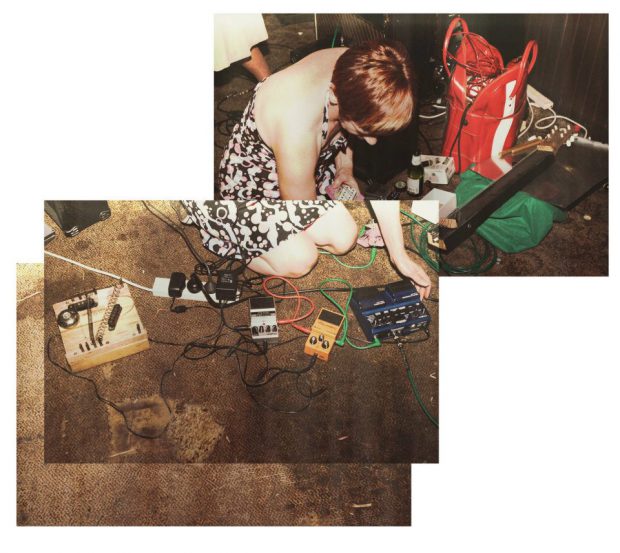Claire Pannell is a WA treasure, and when she’s not conducting experiments in the lab, she’s constructing Frankenbeats using scissors, hydrophones, and shaggy dog stories. She spoke to ZOE KILBOURN ahead of her slinky-supplemented set this Sunday, April 29, at In The Pines.
How has your science background shaped your approach to music-making?
For a long time, music and science were competing endeavours in my life. I have a PhD in Soil Science and Plant Nutrition, and during that time [while I was working on my PhD] I also played in three bands and held down jobs in music – student radio in New Zealand, and then working as a sound engineer and coordinator at a music centre. Technology, on the other hand, is something that I have utilised in music for a very long time – since the early 90s. I would say that the science-arts aspect to my soundmaking came about when I spent a while in a residency at [UWA research lab] Symbiotica exploring plant sounds. Then when a friend and artistic director-choreographer Paul Blackman and Jukstapoz, a dance company in Athens, asked me to create some sound designs for a show, I discovered the amazing world of Foley and field recordings.
What drew you to experimental music? How would you describe your approach to improvisation?
I was naturally drawn to experimental music. Even when I was in bands I had a habit of making the music different, I think. I have always enjoyed the strange and quirky. I was brought up force-fed opera and the Goons’ comedy, so I guess that might partly explain it. I discovered David Bowie as a young age, and then when punk hit there was a huge range of awesome and strange music around that was kind of new wave and experimental. Stuff like Rip Rig + Panic and 23 Skidoo come to mind, but I also got into grunge and hardcore music I guess after that.
You release a lot of your music for free through Dog Park Records, alongside a huge assortment of experimental music. What’s the philosophy behind the Dog Park label, and how do you decide what to release and when?
I release what I like, basically. I seek out tracks too, sometimes with a theme or concept. I have music there from all around the world. I have a big network of lovely experimental friends that I like to listen to and support. When simply depends on when I feel like it, really. It’s organic.

What’s your plan for your In The Pines set? You’ve arranged what sounds like an all-star found-object orchestra – what does the ensemble involve, and how has that come together?
I’ve created what I am calling The Slinky Dinks. It’s an improvisational ensemble technically with a focus on slinkies. I don’t want to say much more than that. The people I have invited to join the Slinky Dinks are Adam Brown, Chrissi Crash, Kit Aliano, Alyshia Gatani, Tatjana Seserko, Lana Rothnie, Eduardo Cossio, Cissi Tsang, Meret Hornstein, Predrag Delibasich, Atsuko Delibasich, Fabian Rojas, Nathan Kelly, Rupert Thomas, Rebecca Orchard, and John Lekias.
Most of these people will be joining me, and hopefully some guests attending, especially children. This came about because I have observed lots of kids at In The Pines and I asked [RTRFM Operations Manager] Chris Wheeldon if I could run a musical instrument-making workshop for them. The people I have invited to join me are people that I respect for their own musical talents, personalities and quirks.
I hope that this won’t be a one-off event. I was intentional in not inviting the usual musicians that one expects for an improv ensemble. I am aiming for a rhythmic soundscape, and I feel that this group will be free enough to respond to meandering while keeping a solid rhythm. That’s the plan, anyway.
What’s your relationship with RTRFM been like?
I’ve found RTRFM incredibly supportive of Perth music. We are incredibly lucky to have a station here that is like a community for the Perth music scene. There are many great shows and they cover most genres and styles. I have to say, it’s one of the best in the world, and I have heard and visited a few [stations] on my tours and times living overseas.
You recently performed a Triffids cover for RTRFM’s Slightly Odway series. How did you adapt your sound to a rock cover?
I did My Baby Thinks She’s a Train. Certainly one of my favourite Perth bands, and I was lucky enough to see them live numerous times. I kept the vocal structure and used that as the basis for the track. I also utilised a spinning metal disk for the train sounds over the top. I guess I did what I usually do with my looper, really. Laying down the basis of the rhythm, this time with vocals first, and then layering that, like speed recording.
Possibly a dumb question: how did you get the Furchick nickname?
I used to wear furry orange pants in New Zealand, because as a Perthite, I found it incredibly cold. I made some fur pants and I guess it stuck somehow after I used the name for a spoken word show.